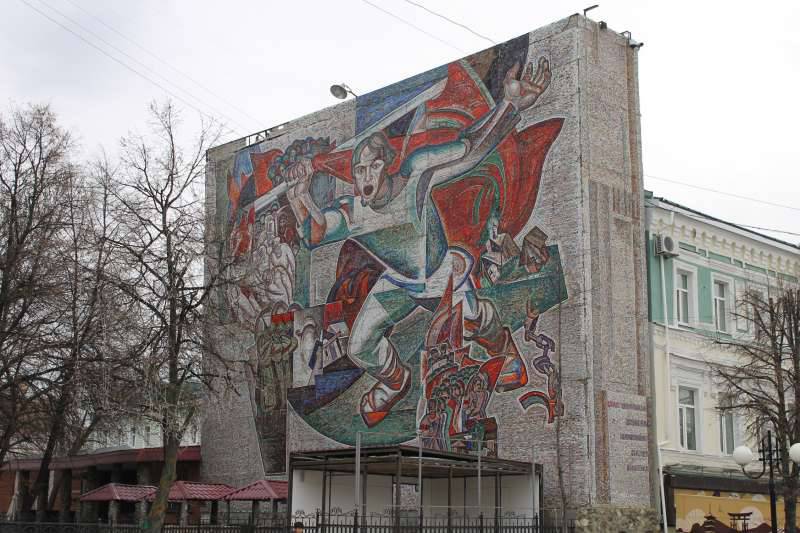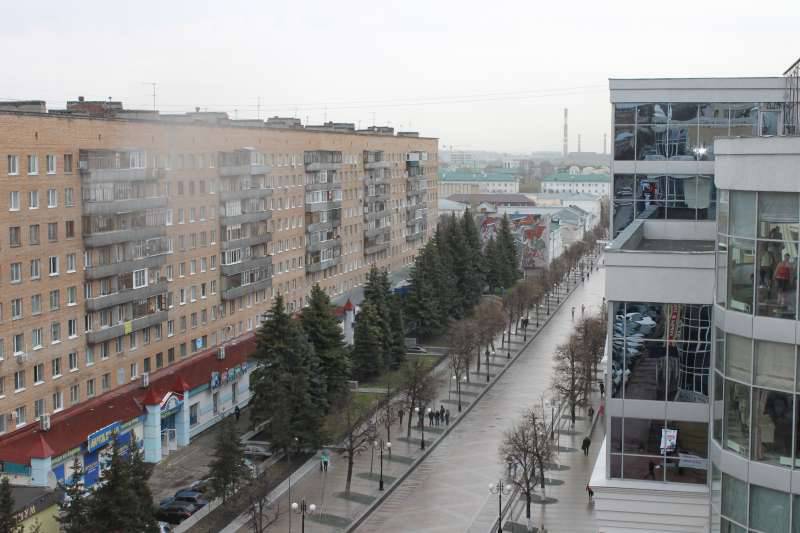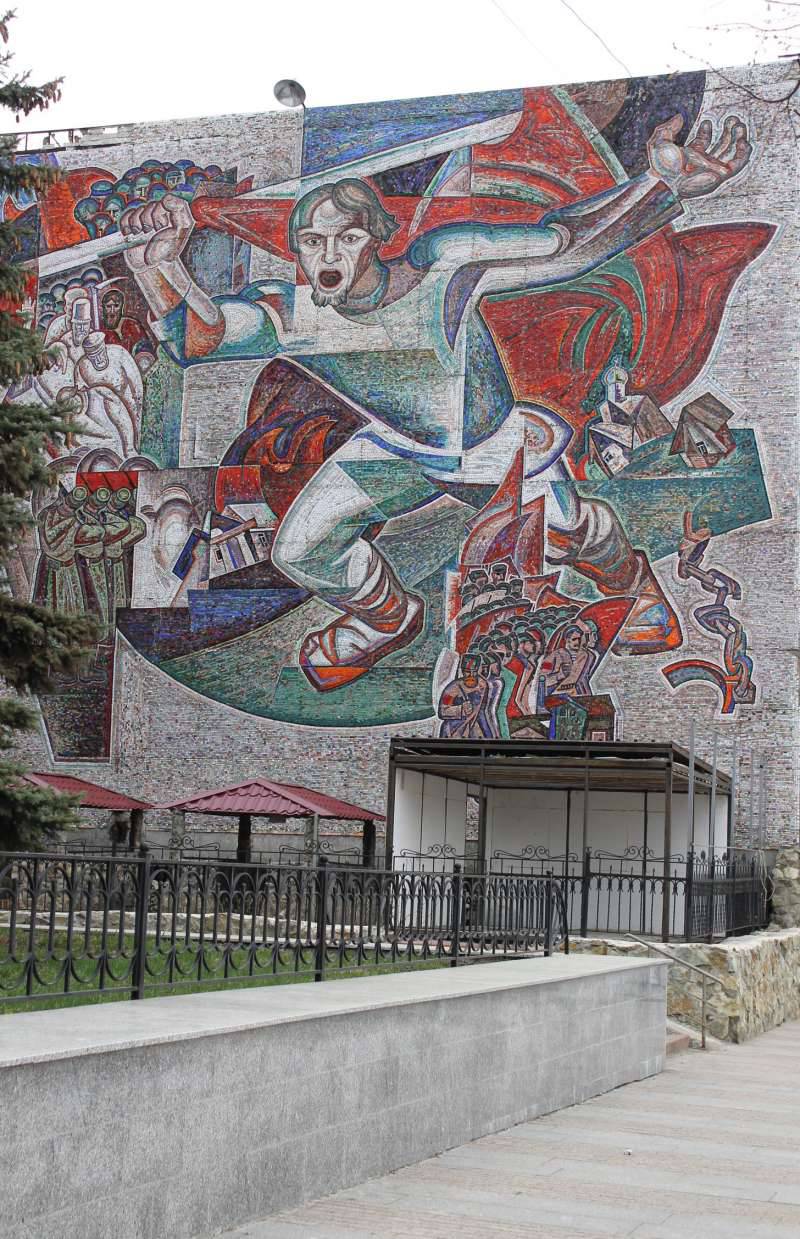155 years from the date of the abolition of serfdom in Russia: Kandievsky uprising in the Penza province
In 2016, 155 celebrated the anniversary of the abolition of serfdom in Russia, and 155 celebrated the events of the largest peasant uprising in Russia in the Penza province, caused by the harsh conditions of the personal liberation of the peasants from serfdom. We do not undertake to judge whether fundamental changes took place in the mass consciousness or whether the masses still perish "for God and the Tsar" in the era of "developed capitalism", but set as a goal to recall an event that, as a matter of fact, is a fundamental social change largely determined further history Russia.
In memory of the Kandievsky uprising in Penza during the Soviet era, this mosaic was installed.
The conditions for the liberation of the peasantry from serfdom, formulated in the "Regulations 19 February", consisting of 19 separate legislation ("Regulations" and "Supplementary Rules"), even by the government of Alexander II were realized as a potential catalyst of popular unrest. Recall that by the year 1860, in accordance with the censuses in Russia, there were almost 2,5 million serfs who continued to trade, their owners laid as well as their estates. According to V.O. Klyuchevsky (one of the most famous historians of the XIX century, also, by the way, a native of the Penza province), two-thirds of the serfs were mortgage to the beginning of the reform.
“The provision on the redemption by peasants who had left serfdom, their manor residency, and on the government's assistance in acquiring field land by the peasants themselves” regulated the peasants ’redemption order. Schematically, the most controversial release conditions are as follows:
- peasants were recognized as personally free and received personal property (houses, buildings, all movable property);
- instead of serfs, they became “temporarily obliged”,
- the peasants did not receive land ownership, only for use;
- land for use was not transferred to the peasants personally, but to rural communities;
- for the use of land it is necessary to serve the serfdom or pay a rent, which the peasants had no right to refuse from for the 49 years;
- the legal capacity of the peasants is limited by estate rights and obligations.
This, in fact, became a stumbling block: the conditional “will”, without a doubt, of land, which for the peasantry is equivalent to starvation. Full freedom and rights, the manifesto stated, “serfs will receive in due time”. In what - it was prudently not reported (apparently, through the notorious 49 years), especially to the future "full-fledged rural inhabitants".
Despite the fact that the manifesto proclaimed that “the Divine Providence and the sacred law of succession” the king relied “on the common sense of Our people”, the government took a number of measures long before the announcement of the manifesto to prevent possible peasant unrest. It should be noted that the preparation was very serious and thoughtful, despite the fact that today mass public opinion, knowing little about these historical events, is often inclined to view peasant uprisings as insignificant and random episodes against the background of common prosperity and prosperity in the Russian Empire.
We refer to the note prepared by the quartermaster general of the Military Ministry, Adjutant General Baron Lieven, in December 1860, “On the provision of measures for the suppression of peasant unrest by troops”. It analyzed the existing deployment of troops in terms of operational response capabilities, if necessary, to pacify peasant unrest. The results of the analysis satisfied the Baron, since they allowed him to conclude that the existing disposition of the troops was generally capable of suppressing unrest that might arise. Subsequently, it was more clearly defined what kind of troops would be involved in the suppression of possible unrest. A partial redeployment of troops through the Council of Ministers was proposed in order to “ensure order in some provinces where there is not enough infantry and cavalry, an early appointment of troops from neighboring provinces ... to suppress any unrest.”
Moskovskaya street. View from the roof of the mall. "Man with the flag" is visible in the distance for the trees.
Closer to the date of the manifesto's announcement, secret instructions were sent to the representatives of the command, in which there was a statement in the annexes, according to which it was necessary "... to maintain order during the upcoming change in peasant life" to send military units to suppress peasant unrest in various provinces .
Some sort of unshaven he has an interesting ...
The ideological front was also ignored. In special secret circulars, clergymen were recommended in church sermons and conversations to explain to peasants the need for conscientious fulfillment of their duties towards landowners. And in case of misunderstandings with landowners, they (the peasants) should have sought "... protection and relief ... legally, without spreading anxiety in society, and with patience expect from the authorities proper orders and actions of justice." For the priests, special “teachings” were drawn up, designed to prepare the peasants for the correct perception of reform and to ensure peace of mind.
An additional measure to stabilize social unrest was even the time of publication of the “February 19 Regulations” —the time of great fast was chosen, when the expected public outrage should be partly compensated for by preparation for absolution, when believers should especially carefully comply with standards of Christian behavior, including Christian long-suffering .
Despite the fact that all procedures were carried out in secret, rumors of a close “gift of will” among the population were avalanche-like. In St. Petersburg, a special message was even published in the newspapers that “February 19 will not make any governmental orders on the peasant case”, but no one has convinced anyone.
Further events confirm the fairness of the fears of the government and the effectiveness of the measures taken by it - a whole wave of peasant disturbances, turning into real uprisings, has risen. They were caused by the obvious weak points of the reform and the dubious "free".
Already in February, unrest swept the provinces of 7, by May their number had increased to 32. The number of troops engaged in suppressing the uprisings is also striking. We use the data of a specialist in peasant reform historian P.A. Zayonchkovsky: “For two months, units of the 64 infantry, 16 cavalry regiments and 7 separate battalions took part in suppressing the peasant movement. Based on these data, they directly participated in suppressing the peasant movement of 422 infantry companies, 38 1 / 2 cavalry squadrons and 3 hundreds of Cossacks. ” This list is apparently incomplete, since some of the documents could not be saved.
The most large-scale uprisings took place in Kazan (in the village of the Abyss) and Penza (in the Chembarsky and Keren districts) provinces. After the “void riots”, the Kandia uprising became the largest in terms of the number of participants. They covered 10 of thousands of people in 26 villages of the Penza province: Chernogay, Kandievka, Vysokoe, Pokrovskoye, Chembar. The reason for the speeches was the widespread belief of the peasants that they were hiding the real conditions of the “will” from them, and they should not work for the landlords anymore. It was the corvor was the most ruinous for the peasants: the work on the land of the owner took the time needed to process their own plot.
In the Penza province, this condition was particularly difficult. Even General A.M. Drenyakin, who led the suppression of the uprising in the Penza region, agreed that "the Penza province, on its many lands, ease corvee and underwater duty in favor of the landowner can not boast." The same opinion is expressed by his adjutant, Second Lieutenant Hudekov. The general also expresses his opinion on the reasons for strong peasant uprisings in the Penza province (after 25 years after the events in the magazine “Old Russian”): the lack of local landlords, they are not always good governance, burdened the peasants with additional force, the priest Fyodor Pomerantsev, clerk Luke Koronatova, Leonty Egortseva, who sowed distemper and told about the existence of a "golden certificate for pure will."
Also corvee as a form of exploitation was common in church and monastic lands. Recall that the protest covered not only the peasantry (including the well-to-do), both soldiers and clergymen took part in the uprising.
In the villages of Chembarsky district (Studenki, Pokrovskoye), the peasants gathered at gatherings and, in their own way, interpreted the terms of the manifesto in their favor. The leaders of the rebel peasants - Leontiy Egortsev, a resident of the Kandiyivka village, Andrei Elizarov, a retired grenadier, Fyodor Pomerantsev, a priest, a soldier Vasily Goryachev, Gavrila Streltsov, Anton Tikhonov - traveled around the villages with a red flag and convened the people in Kandievka to resist the manifesto.
There is little information about the leaders of the rebels, and even those are rather contradictory. One of the leaders of the uprising - Leonti Yegortsev - was a Molokan, that is, a fan of a variety of Christian doctrine, recognized by the church heretical, whose followers recognize the worship of God only in the "spirit of truth", do not recognize the icons and the cross that connects this trend with Protestantism. The Kandia uprising by his suppressor, General Drenyakin, is called a riot "with a touch and methods of pugachevism." This is probably due to the fact that Leonty called himself the Grand Duke Konstantin Mikhailovich, who died thirty years before the events described.
In the uprising, which is indicative, five clergymen participated, but only the name of Fyodor Pomerantsev remained. There is information about Vasily Goryachev, a peasant from the village of Trinity 26 years. He was temporarily a vacation of the Life Guards Egersky regiment, had a bronze medal on the Andreev ribbon in memory of the war 1853 — 1854. In Kandiyevka he said that “one must stand for the peasants”, that “there is nothing to persuade the people, he will not work for the landlords”.
Starting on 2 on April 1861, the protest initially proceeded in active forms: the peasants looted the estates, took away livestock, attacked the troops, captured soldiers who were threatened with execution, but they themselves suffered losses.
Since April 9, in the center of peasant unrest, in which three thousand peasants gathered, turned out to be the village of Chernoghai of the same Chembar district. There, the peasants attacked a company of the Tarutinsky infantry regiment, called to pacify them. The company retreated, and one non-commissioned officer and a private were taken prisoner. But the rebels in Chernogai did not linger, because two infantry companies were sent there, but transferred to Kandiyevka, which was the culmination of the uprising: 10 thousands of people from four districts of the Penza and Tambov provinces gathered there.
With nine infantry companies, General Drenyakin took Kandiyevka to his entourage and began negotiations with the rebels, sending a priest to them. The general was astounded by the persistence of the peasants, even under the threat of force. He writes that even after the shots they got up and continued to hold on. He finds the explanation in the false conviction of the peasants that they should not "serve serfdom", as stated in the conditions of liberation, but "beat off serfdom", as Leonty Egortsev and Fyodor Pomerantsev interpreted to them. And the fact is that if they “do not beat off the serfdom” before Easter, they will forever remain in serfdom.
But there was no unity among the peasantry — while some were standing to death, others supplied help to General Drenyakin: by an open order of which, transmitted through the headman, rebellious Kandiyevka put carts and people to deliver from the village of Poim company to reinforce the detachment of punitive troops. The carts were prepared in the morning, but not needed - a tragic denouement has already occurred. April 18 after a three-time salvo, regular troops launched a surprise attack; as a result, 410 people were captured. After that, the peasants retreated to the village, some of them ran into the field, they were not pursued. At night, a significant part of the rebels dispersed to their villages.
As a result of the April 18 clash, 9 people were killed on the spot, 11 died later from injuries; there were no casualties in the troops. In all, three volleys were given to the rebels, a 41 bullet was fired. Given that the soldiers of the regular troops fired, such low accuracy most likely indicates an unwillingness to fight against their own people.
In the case of peasant unrest in the Penza province, 174 was condemned by the participant of the performance, 114 of them were exiled to penal servitude and settlement in Siberia after public punishment. 28 people were punished by gauntlets, driven through 100 man 4 to 7 times and then exiled to hard labor for 4 to 15 years; 80 people were driven through the ranks from 2 to 4 times and sent to Siberia, 3 people were punished with gauntlets and sent to serve in battalions, 3 people were imprisoned from 1 years to 2 years, 58 people were punished with rods, followed by release. In addition, 7 people of retired and vacation soldiers who participated in the uprising, including 72-year-old old Elizarov, were exiled to Siberia were sentenced to various punishments. In the report of General Drenyakin it was stated: “Priest Fyodor Pomerantsev, a widower, I have sent my opinion as an example to others forever in the Solovetsky Monastery. In addition, I mean more 4 priests, disapproving of leading on the occasion of the declaration of the Manifesto.
Vasily Goryachev, a peasant who first raised the red flag, was deprived of his military rank, punished by 700 with blows of gauntlets and exiled to remote Siberian mines for 15 years.
Leonty Egortsev fled to the Tambov Gubernia (of which he was a native). A reward was announced for his head, but if there were no volunteers, he wouldn’t have time: he died suddenly next month. According to General Drenyakin, his body was dug out from the grave to make sure that this self-appointed prince was dead.
Despite the awarding of General A.M. Drenyakin Order of St. Stanislav 1 degree with the wording "in reward prudent orders to restore order between the worried peasants of the Penza province," public opinion, especially in democratically-minded circles, condemned the general. So, the newspaper "Bell", published in London A.I. Herzen, published a whole series of articles about the massacre of peasants in the Penza province, who refused to perform serfdom after “liberation” from serfdom (“Russian blood is shed!”, “12 April 1861”, “Hero of our time and their Petersburg ...”, "Gurko is not Apraksin!", "Earl Apraksin received for beating ..."). Special resentment caused the fact of awarding punitive honorary royal awards. The last article was published in The Brave Drenyakin: “The brave Drenyakin presented to the award the“ young men ”who killed the peasants, our brothers of the Russian peasants. What to reward them with? It is necessary to write out Austrian or Prussian crosses - not to reward Russians for Russian blood! ”
For the first time in the history of the country during the Kandievsky peasant uprising, the Red Banner was raised as a symbol of struggle. Adjutant Drenyakina describes the moment in this way: “A red large handkerchief was hung on a high pole depicting a banner, and as such this symbol of peasant disorder was transported to villages. The masses of peasants, women and children followed this original train. ” Drenyakin himself also described this event: “Vasily Goryachev, temporary-temporarily, the Life Guards of the Egersky Regiment ... carried the banner of will out of the red bucket on a pole through villages and villages.”
With the uprisings in the Abyss and Kandiyivka, the struggle of the peasants began for their own understood justice and "real will", for the abolition of the redemption payments, which lasted 44 year. However, when the dream became a reality, and a manifesto was issued on the abolition of the redemption payments in 1905, the amounts paid by the peasants for their will have many times exceeded the value of the land itself by 1861 a year.



Information